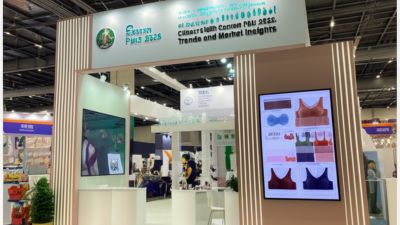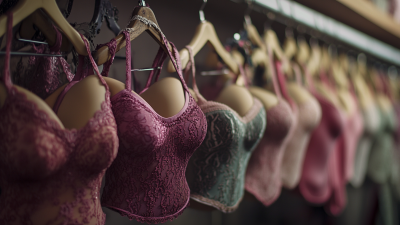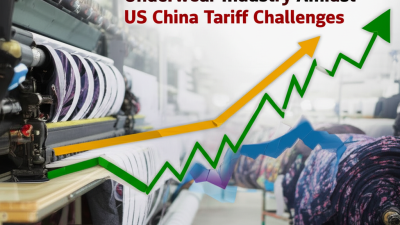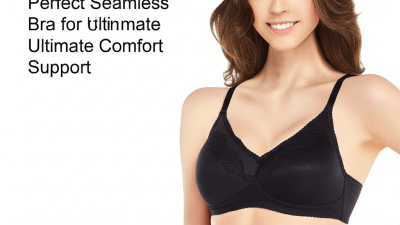Exploring the Future of Breathable Bras at China's 138th Canton Fair 2025: Trends and Market Insights
 As the 138th Canton Fair approaches in 2025, the fashion and undergarment industry is poised for a significant leap forward, particularly in the realm of breathable bras. This event, renowned for its comprehensive showcase of innovative products and market trends, is becoming a focal point for brands and manufacturers looking to capture the burgeoning consumer demand for comfort and functionality in lingerie. The breathable bra, characterized by its lightweight materials and moisture-wicking properties, is not only revolutionizing the way women perceive comfort in undergarments but is also driving new sustainability initiatives within the industry. With a growing awareness of the importance of breathable fabrics, the Canton Fair will serve as a pivotal platform for industry leaders to reveal their latest designs, technological advancements, and consumer insights that will shape the future landscape of breathable bras. As we explore these emerging trends and market insights, it becomes evident that the evolution of this essential garment is not just a passing fad but a significant shift towards more innovative and consumer-centered undergarments.
As the 138th Canton Fair approaches in 2025, the fashion and undergarment industry is poised for a significant leap forward, particularly in the realm of breathable bras. This event, renowned for its comprehensive showcase of innovative products and market trends, is becoming a focal point for brands and manufacturers looking to capture the burgeoning consumer demand for comfort and functionality in lingerie. The breathable bra, characterized by its lightweight materials and moisture-wicking properties, is not only revolutionizing the way women perceive comfort in undergarments but is also driving new sustainability initiatives within the industry. With a growing awareness of the importance of breathable fabrics, the Canton Fair will serve as a pivotal platform for industry leaders to reveal their latest designs, technological advancements, and consumer insights that will shape the future landscape of breathable bras. As we explore these emerging trends and market insights, it becomes evident that the evolution of this essential garment is not just a passing fad but a significant shift towards more innovative and consumer-centered undergarments.
Innovative Designs in Breathable Bras for 2025: A Look Ahead
As the 138th Canton Fair approaches in 2025, the spotlight turns to the innovative designs that are shaping the future of breathable bras. Consumers are increasingly seeking comfort without sacrificing style, leading designers to explore new materials and cutting-edge manufacturing techniques. Advances in moisture-wicking fabrics and lightweight structures are becoming essential in meeting the demands of modern women, who prioritize both functionality and aesthetics in their intimate apparel.
The upcoming event is set to showcase a variety of concepts, including seamless construction and adjustable features that enhance the fit and support of breathable bras. Eco-friendly materials are also gaining traction, reflecting the growing consumer consciousness around sustainability. Brands are experimenting with designs that not only cater to diverse body types but also feature trendy prints and colors. This fusion of innovation and style promises a transformation in how breathable bras are perceived and worn, making them a staple in every woman's wardrobe in 2025 and beyond.
Consumer Preferences Shaping the Future of Breathable Bras in China
As the lingerie market continues to evolve, consumer preferences play a pivotal role in shaping the future of breathable bras in China. The increasing demand for comfort and functionality among consumers reflects a notable shift towards materials that prioritize breathability and inclusivity. This trend arises from a desire for stylish yet practical undergarments that can enhance daily life, emphasizing both well-being and self-expression.
Tips: When choosing a breathable bra, pay attention to materials like cotton or moisture-wicking fabrics that ensure comfort throughout the day. Additionally, consider your body type and opt for designs that provide adequate support while maintaining a delicate aesthetic.
With the global lingerie market projected to reach USD 163.6 billion by 2035, brands must stay attuned to the changing dynamics of consumer preferences. The integration of technology into fabric design is also becoming significant, allowing for innovative features such as temperature regulation and seamless construction, which further enhances the appeal of breathable bras.
Tips: Look for brands that offer custom sizing options, ensuring a perfect fit that caters to diverse body shapes. Engaging with online reviews and feedback can also guide your decisions, helping you discover products that truly resonate with your needs.
Sustainable Materials and Eco-Friendly Practices in Bra Manufacturing
At the 138th Canton Fair in 2025, the focus on
sustainable materials and eco-friendly practices in
bra manufacturing highlights an evolving industry that prioritizes both
comfort and environmental responsibility. Manufacturers are increasingly exploring innovative
textiles made from organic fibers, recycled materials, and biodegradable options, which not only reduce the carbon footprint but also offer
breathability and comfort for the wearer. These advancements are crucial in meeting the growing consumer
demand for products that align with eco-conscious values.
Furthermore, eco-friendly practices extend beyond materials. Many brands are adopting sustainable production
methods, such as reducing water usage, minimizing waste in the manufacturing process, and implementing
energy-efficient technologies. The integration of sustainable practices is not merely a trend; it reflects
a fundamental shift within the industry aiming to foster long-term ecological balance. As these brands gather
insights and trends at the Canton Fair, they are positioned to lead a movement towards a more responsible
and attuned bra market, capturing the hearts of consumers who seek
both style and sustainability.
Emerging Technologies Enhancing Comfort and Fit in Women's Lingerie
At the 138th Canton Fair in 2025, the focus on breathable bras will shine a light on emerging technologies that enhance comfort and fit in women's lingerie. The global lingerie market, currently valued at approximately $42.9 billion, is projected to grow at a CAGR of 6.9% from 2023 to 2030, driven primarily by innovation in fabric technology and consumer demand for greater comfort. Reports indicate that breathable materials, such as moisture-wicking fabrics and advanced mesh constructions, are becoming increasingly prevalent, allowing for improved airflow and reduced chafing during wear.
Innovative technologies like 3D knitting and seamless construction are revolutionizing the way bras are manufactured, offering personalized fits that cater to a diverse range of body shapes and sizes. According to a study published by Grand View Research, the rise of smart textiles, which can adapt to body temperature and moisture levels, is expected to reshape consumer expectations. Brands that invest in these technologies are likely to see significant advantages in market share, as today's consumers seek not only style but also functionality in their lingerie choices. As the industry continues to evolve, the spotlight at the Canton Fair will undoubtedly highlight how these advancements are not just trends, but essential shifts towards a more comfortable, inclusive future in women's fashion.
Emerging Technologies Enhancing Comfort and Fit in Women's Lingerie
This chart illustrates the preference for various technologies in breathable bras based on a survey conducted at the 138th Canton Fair. The data reflects the percentage of respondents favoring each technology for enhancing comfort and fit.
Market Growth Opportunities and Challenges for Breathable Bra Brands at the Fair
The upcoming 138th Canton Fair in 2025 presents a unique opportunity for breathable bra brands to capitalize on the growing demand in the intimate apparel market. According to a recent report by Grand View Research, the global intimate wear market is projected to reach $106.41 billion by 2025, with breathable bras driving a significant portion of this growth. This trend is fueled by increasing consumer awareness of comfort and functionality, as well as a shift towards sustainable fabric technologies that promote airflow and moisture wicking.
However, brands must navigate several challenges to seize these market opportunities. Competition is intensifying, with both established players and new entrants vying for market share. A report from Statista indicates that the breathable bra segment is expected to see a Compound Annual Growth Rate (CAGR) of 7.5% over the next five years, underscoring the potential for innovation in design and material use. To stand out, brands must not only offer superior product performance but also effectively communicate their value propositions, including eco-friendliness and health benefits, to attract a discerning consumer base at the fair.

Home
Products
One-Piece Bra
Adhesive Bra
Tank Top Bra
Knit Bra
About Us
News
Contact Us




 As the 138th Canton Fair approaches in 2025, the fashion and undergarment industry is poised for a significant leap forward, particularly in the realm of breathable bras. This event, renowned for its comprehensive showcase of innovative products and market trends, is becoming a focal point for brands and manufacturers looking to capture the burgeoning consumer demand for
As the 138th Canton Fair approaches in 2025, the fashion and undergarment industry is poised for a significant leap forward, particularly in the realm of breathable bras. This event, renowned for its comprehensive showcase of innovative products and market trends, is becoming a focal point for brands and manufacturers looking to capture the burgeoning consumer demand for 




